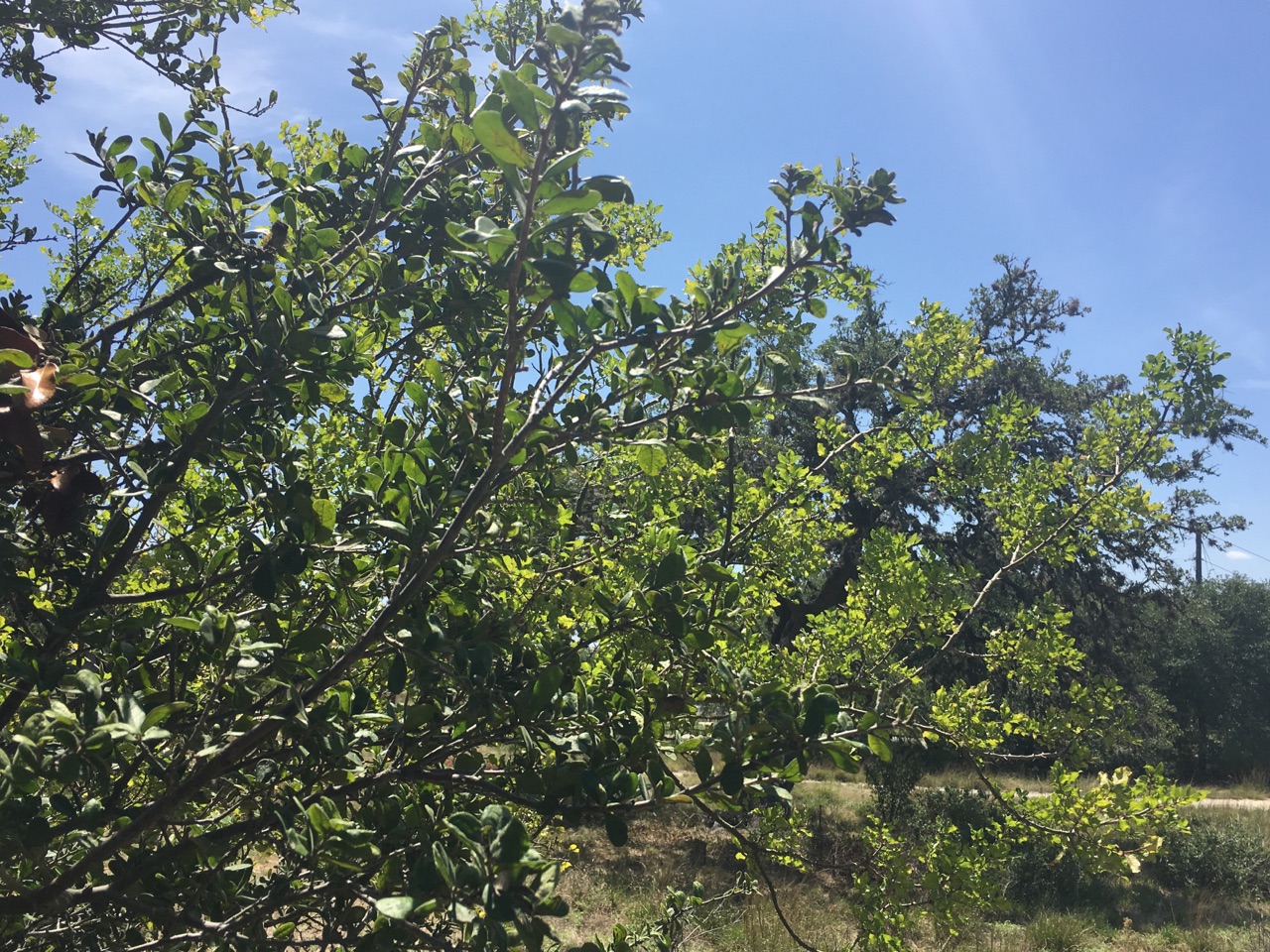Have you seen the movie The Other Guys with Will Ferrell and Mark Wahlberg? They’re NYPD detectives who work the dull cases in the shadow of the superstar detectives who catch the big crimes and the public spotlight. At the risk of spoilers if you haven’t seen the movie (currently on Netflix), “the other guys” eventually save the day when the superstars make an untimely exit. Recently, a friend who is doing some brush clearing around her home asked us about prickly ash. In removing a considerable amount of cedar and agarita that was surrounding live oaks, she uncovered some well-sized prickly ash. Despite its painful thorns she liked the look of it, but had only heard less than positive things about this prickly shrub that can grow up to 15 feet. She asked us what we thought of prickly ash which got us to thinking about The Other Guys or, rather, the other trees. There’s no doubt that, in Texas, live oaks are the superstars. With their historical allure, evergreen leaves, and weighty trunks and branches, other woody plants often can only live in their grand shadows. But live oaks are also susceptible to untimely exits thanks to oak wilt and incessant drought, while these other trees, the Will Ferrells and Mark Wahlbergs of woody plants, are mostly drought tolerant, provide wildlife cover and food and, actually, aren’t too bad looking.
THE OTHER TREES
Prickly Ash
This spiny shrub can grow into a 15-foot tree. Easily identified by the considerable thorns – considerably painful thorns if you’ve ever tangled with them – on its trunk and branches, the prickly ash is also known as the “toothache tree” or “tickle-tongue” due to the numbness experienced when its leaves, bark, or twigs are chewed on. The Native Americans and early settlers used the tree to soothe toothaches. The prickly ash has shiny green leaves that are browsed by deer and produces reddish-brown fruit eaten by birds. It is also a host for plant for the Giant Swallowtail. Learn more about the prickly ash from Texas Parks & Wildlife.
See the Lady Bird Johnson Wildlflower Center Prickly Ash image gallery
Texas Persimmon
The Texas persimmon is found mainly in Central and Southern Texas. This “gnarled, grey shrub with grey, peeling bark” similar to a crape myrtle prefers partial shade and rarely grows over eight feet tall; it’s often found thriving under live oaks. The Texas persimmon requires both male and female trees to be present for the female tree to produce fruit. When the persimmon fruit fully deepens to a black-purple color it is edible not only for wildlife, but humans as well. Despite being full of seeds, for those with patience, the sweet persimmon flesh makes for a tasty jelly. Learn more about the Texas persimmon from Foraging Texas.
See the Lady Bird Johnson Wildlflower Center Texas Persimmon image gallery
Yaupon Holly
Some consider the yaupon holly an invasive, but it’s native to Texas and, really, who could stay mad at those bright red berries and shiny evergreen leaves? Happy holly days! The yaupon holly’s species name, Ilex vomitoria, derives from the use of the berries by Native Americans in a tonic to make themselves vomit during purging ceremonies. According to Wild Edible, the leaves of the yaupon “contain more caffeine by weight than both coffee beans and green tea and it has the highest caffeine content of any plant native to North America. Yaupon holly is also high in antioxidants and less bitter than green tea.” Yaupon holly tea made from the roasted leaves is similar in taste to South American yerba mate. Learn more about yaupon holly and folks in Texas making yaupon tea from NPR.
See the Lady Bird Johnson Wildlflower Center Yaupon Holly image gallery
Flameleaf Sumac
It’s hard to not feel a twinge of jealousy when autumn arrives and the leaves change color in the Northeast. Oh, to be in Vermont. But before you book a flight and an overpriced inn in New England, take a tromp around your own property this fall. There, tucked amongst the ashe juniper and oaks, you may see a brilliant fall show courtesy of the aptly named flameleaf sumac, a slender-branched, deciduous native tree that grows to around 30 feet. As described by Texas Agrilife, the flameleaf sumac “usually grows in small mottes or clusters, as the plant can spread by rhizomes…The leaves are long, narrow, compound and located alternately along the stem.” In early summer, “small, whitish flower clusters occur on the tips of the branches and mature into rounded, red fruits.” And, then, in the fall, “the leaves turn a showy shade of red…” Vermont has nothing on the flameleaf sumac.
See the Lady Bird Johnson Wildlflower Center Flameleaf Sumac image gallery
Madrone
Few trees will stop folks in their tracks like the madrone. This typically multi-trunked evergreen tree grows 20-30 feet with, as the Lady Bird Johnson Wildflower Center so aptly describes, “stout, crooked, spreading branches (that) form a distinct crown” and a “colorful, exfoliating outer bark (that) reveals polished, red, inner bark.” In early spring, the madrone produces small white flowers that become yellow-orange to bright red berries in the fall. With its red bark and colorful berries, the madrone is already a showstopper, but, because it is also “temperamental to propagate or grow…and it is very difficult to transplant successfully from the wild” it is also a rarity to see which only adds to its allure.
See the Lady Bird Johnson Wildlflower Center Madrone image gallery
Photo, top, prickly ash.









